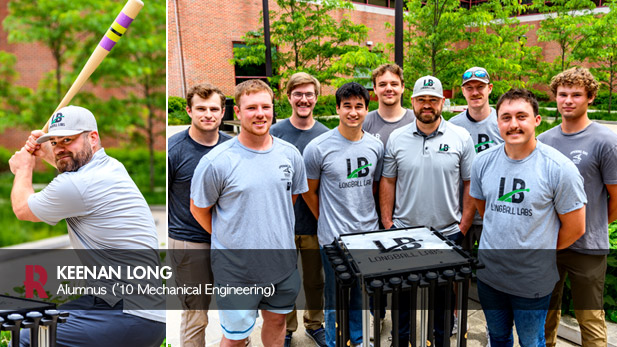Home Run Project: Mechanical Engineering Students Helping Alum Transform Baseball with Bat Tech

Alum/former baseball standout Keenan Long and his LongBall Labs startup turned to Mechanical Engineering Department’s capstone design program and teams of graduating seniors to help develop a mobile bat testing system.
When Major League Baseball players Byron Buxton, Jorge Polanco, Ty France, and Trevor Story step to the plate clutching their maple bats, they’re not just holding wood—they’re wielding science. And the difference between a frustrating warning-track flyout and a game-winning homer might be the innovative technology being introduced to America’s favorite pastime by a Rose-Hulman alum and creative students.
Groups of mechanical engineering seniors have spent the past four years perfecting a mobile bat testing system for LongBall Labs, a startup founded by 2010 alumnus Keenan Long. His expertise in bat technology is already making a measurable difference for dozens of Major League Baseball players by identifying the subtle variations in seemingly identical bats that can add considerable feet in a batted ball distance.
"Those eight to 18 extra feet of batted ball distance can change everything," said Long, a former standout Rose-Hulman baseball player and member of the Institute’s Athletic Hall of Fame. "We have documented evidence of our technology converting long fly ball outs into homers, helping change the outcome of several games already this season."
Watch the Video
In an era where pitchers have benefited from high-speed cameras and biomechanics analysis, LongBall Labs is tilting the playing field back toward hitters through meticulous bat analysis.
The problem is surprisingly basic: two bats with identical specifications—same manufacturer, same model, same listed weight and length—can perform dramatically differently. LongBall's testing has revealed shipments to professional players with as much as 1.5-ounce differences in barrel mass, significantly affecting how a bat performs.
"The physics is clear," said Long. "For every 1 mph increase in exit velocity, the batted ball will fly four to six feet farther. Considering our clients typically gain two to three miles per hour when employing our services, they will see flyouts being converted into home runs. For our clients, we have seen this happen 15 times already this season and it’s not even June yet."
For players like Buxton, Polanco, France, and Story, swinging a bat that's just slightly off their optimal specifications could mean losing several feet of distance—turning potential home runs into warning-track outs. All four players are off to successful hitting starts this season using bats recommended after testing by LongBall Labs.
More players may soon benefit from this technology as the latest capstone project team, with six graduating mechanical engineering seniors, perfecting development of the proprietary mobile bat testing systems that could help LongBall Labs build on its first enterprise level team partnership to service multiple teams across the league. The team’s work has standardized the production and operation of the measurement systems to help the company scale up quickly.
"This project and relationship with Rose-Hulman has been a dream come true for me," Long explained. "I couldn't have done all this research and development as quickly on my own. When I needed assistance, I thought of Rose-Hulman right away. I knew the students and their can-do attitudes would get things done. These measurement systems will set us on a path to expand our business, hire more employees, and reach out to more potential clients."
The project also has been a hit for the six graduating seniors, allowing them to integrate their product design, manufacturing, and testing skills with their love of sports, with four team members being Rose-Hulman baseball players and another being a soccer player.
"Working with LongBall Labs was perfect, enjoying my love for baseball while applying the skills I've learned at Rose-Hulman," said Rose-Hulman outfielder Kade Kline, who spent countless hours manufacturing custom pieces for the testing device.
Each team member brought specialized expertise to this year’s project:
Alec Lewandowski, a pitcher and team captain for the 2024-25 Fightin’ Engineers, managed communications and product testing throughout the year-long project: "Having a client (LongBall Labs) invested in both our learning and the project's real-world impact made this the ideal capstone experience."
Collin VanDerHulst, another baseball player, focused on materials analysis: "LongBall Labs allowed me to apply my engineering ability directly to my passion for baseball."
Mark Serdinak handled CAD modeling and assembly. "It's satisfying seeing our work have an immediate effect on the sport I enjoy."
Jimmy Hall applied mechatronics and programming. "I've enjoyed combining sports with engineering and seeing an immediate impact."
Andres Aguado worked on manufacturing and feasibility. "It's exciting to work with an emerging business that works with players on my favorite (MLB) teams."
The project exemplifies Rose-Hulman's commitment to hands-on, industry-connected education while showcasing how student innovators can make meaningful contributions to industry. Also, Long's path from Rose-Hulman's baseball diamond to MLB tech innovator showcases the institution's impact on sports engineering.
After graduating in 2010 and a short-lived career playing in independent baseball, Long developed patented bat technology with Easton Sports, including introduction of Easton's power boost knob technology. He returned home to Chicago to complete a master’s in business administration at Northwestern University's Kellogg School and then combined his engineering and business skills to build his own bat lab to study big league bats, eventually founding LongBall Labs in 2020.
"It seems my whole life has been centered around bats, as a player and now an engineer and entrepreneur,” he said.
Long's bat technology expertise has become particularly relevant as baseball buzzes about "torpedo bats," a trend where bat designs move more wood into the label area to adjust the location of the sweet spot. He has been featured in interviews with MLB Network, Sports Illustrated, New York Times, Sports Business Journal, and Marquee Sports Network.
As the 2025 MLB season progresses, the impact of Rose-Hulman's engineering expertise—by alumni and students—will continue to be felt with every swing of a LongBall Labs-tested bat. It proves that at Rose-Hulman, engineering education is truly a home run.